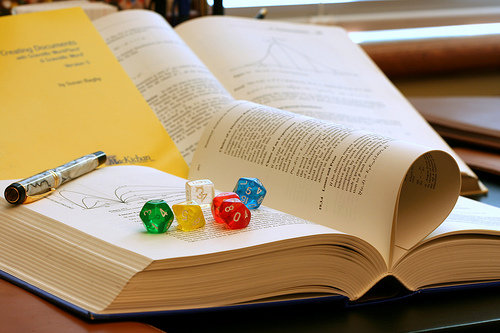Overview: Chance and Probability
Geneticists use the principles of chance and probability to express the results of genetic experiments with pea plants, as well as other plants and animals. In mathematical terms, probability refers to the fraction (or percentage, in decimals) of times an event can occur. According to the product rule for independent events. the probability of events occurring together is the product of the probabilities for each event multiplied. For example, the probability of a girl being born is 50 % , but the probability for two girls being born in the same family is 50% x 50% =25%. This does not necessarily mean that a specific family will have a girl if another family has a boy at the same time, just that the overall probability, in a sample of many, will be 50%.
Predicting Genetic Crosses
In Mendel’s experiments, seven simple genetic factors were manipulated, such as whether the seed is round or wrinkled, the pod is green or yellow, and so on. At the time those experiments were formed, the way that alleles separate during meiosis and other details of cellular reproduction were not known. Geneticists assume that alleles segregate during meiosis in a 1:1 ratio, and that gametes combine randomly. Suppose the dominant gene for round seeds is called R and the recessive form ( for wrinkled seeds) is called r. One heterozygous parent with phenotype Rr mated with another heterozygous parent with phenotype Rr will have offspring with the probability (1/2 R +1/2 r)(1/2 R + 1/2r) or 1 RR, 2 Rr, 1rr for genotypes, and 3 with round seeds and 1 with wrinkled seeds. Geneticists often use thousands of trials to produce as many offspring as they can to use the rules of probability,
Punnett Squares and Testcrosses
The range of probable genetic crosses can be demonstrated by drawing a simple grid with all the alleles contributed by one parent on one side and the other parent on the other, then showing each possibility in each square of the grid. That way, all the possibilities can be accounted for. https://schooltutoring.com/wp-content/uploads/sites/2/2013/07/punnett-square-green-peas.jpg
Both parents, in this case, contribute G and g. In addition, biologists can perform a testcross if they have the phenotype to discover the genotype. In the example above of the green pods, the genotype could be GG or Gg. By crossing it with a plant with yellow pods (gg), if the genotype is GG, all the offspring will have genotype Gg and have green pods. If the genotype is Gg, half the offspring will have genotype Gg, with green pods. The other half will have genotype gg with yellow pods.
Monohybrids and Dihybrids
Some hybrids have only one trait, involving one pair of alleles, and others involve separate pairs of alleles and two separate traits. When only one trait is involves, the possibilities are simple, and the Punnett square is a simple 2 X 2 grid. A relatively simple trait in humans is whether earlobes are free (dominant) or attached (recessive). If two individuals are heterozygous for the trait, their offspring might have the following genotypes: EE, Ee, Ee, and ee. If two separate traits are involved, the Punnett square will be larger because of the many different possibilities. For watermelons, solid color green (G) is dominant over striped green (g), and short length (S) is dominant over long (s). If a green , short watermelon (GGSS) is crossed with a striped, long watermelon (ggss), the grid grows to 4 X 4, with 16 different genotypes in the second generation.
Incomplete Dominance
Not all alleles are dominant or recessive, however. Sometimes, both alleles are expressed. For example, short tailed cats have one gene for no tail(TN) and one gene for long tail (TL). If two short tailed cats are crossed, the Punnett square has a simple 2 X 2 grid, and the offspring probabilities include 25% long tail (TLTL), 50% short tail (TNTL), and 25% no tail (TNTN). The roan (reddish-brown) color of some cattle also results from incomplete dominance, as well as many other features of plants and animals.
Interested in Science tutoring services? Learn more about how we are assisting thousands of students each academic year.
SchoolTutoring Academy is the premier educational services company for K-12 and college students. We offer tutoring programs for students in K-12, AP classes, and college. To learn more about how we help parents and students in Grand Rapids, MI visit: Tutoring in Grand Rapids, MI



